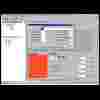Gigasampler Tutorial: Lesson 10
Tascam
Gigastudio home
With this lesson I will end the patch description and the ideas for giga-programming. In this lesson I'll talk about the "keyboard" dimension, which is incredible useful in a "live" use of gigasampler.
Load the file "keyboard.gig" into the editor. It is very similar to the patch "guitar1.gig" described in the first lesson of this tutorial. You will see a region (which covers different notes) with four splits, assigned to the "keyboard" dimension. To each of these splits are assigned different samples of my guitar: clean, distorter, power chord and muted. If you refer to lesson 1, with the patch guitar1.gig, you will remember that in that case you could switch from a sample to another by acting on the CC1 controller (modwheel). Even if this is very useful when you are sequencing with a piano-roll, it is terrible to use "live", because you don't have a precise control of what you are doing.
Now load the "keyboard.gig" patch and play the E over the central C of your keyboard. You should listen to the power chord of and electric guitar. OK. Now move an octave lower, and press for a while the C# (as indicated in figure 1). If you now play again the E you should now listen to the clean guitar sound. The keyboard dimension let you choose which split to play not with controllers, but with the keys of your masterkeyboard. You can choose what keys to use for this control by double clicking on the instrument's name (see the arrow in figure 2), and be selecting the MIDI number of notes in the "KEY # DIMENSION LOW" e "KEY # DIMENSION HIGH" cases. In my example, the numbers 48 and 51 indicates the range of notes C, C#, D, D# of figure 1. These four notes are linked to the four splits fo the keyboard dimension, so that if you press them for a while, you are able to choose what split to play, exactly like if you were acting on a controller.
With this method, you have a more precise control on "what" you are actually playing! In the cakewalk file "piano_roll_dimension.wrk" I show you how to use this dimension. If you open the piano roll window you will see some notes that are actually "played" and compose the guitar harmony (for E to B). Then, there are some "control notes" (C, C#, D, D# of lower octave) which select the sample to be played. These are played a little before you want to change your sound. It is important, both in live and in sequencing, that the control notes are played before you want to change your sound.
If you are sequencing, and you have to transpose your melody, you should remember to transpose ONLY the notes which plays the melody, and NOT the control notes!
|
fig.1
|
fig.2
|
Files
Keyboard.gig
piano roll example.wrk (cakewalk file)
Lesson Index
Back to lesson 9
Continue to lesson 11
You
don't see frames?
Click here!

